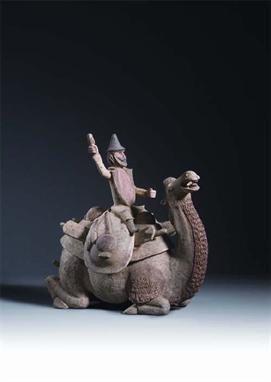We found 627780 price guide item(s) matching your search
There are 627780 lots that match your search criteria. Subscribe now to get instant access to the full price guide service.
Click here to subscribe- List
- Grid
-
627780 item(s)/page
A group of Japanese works of art, mostly 20th century, comprising: two cloisonne enamel plates, Meiji period (1868-1912), of circular form, worked with insects and birds amongst flowers, on a blue ground, 30.5cm. diameter (af); a rectangular lacquer box and cover decorated with a scene of Mount Fuji; a large lacquer box and cover in the form of a temple shrine; a modern model of a kabuto (helmet); and a bronze temple bell; together with a wood carving of a musician (af) (7)
A Western Indian model of Khandoba and Mhalsa, the long legged horse stands four square, 19th century, 31.5cm. Provenance: Ernest Ohly Collection. Khandoba is a regional Hindu deity, worshipped mainly in the Deccan plateau of India. The cult of Khandoba has links with Vaishnava and Jain traditions and developed during the 9th and 10th centuries from a folk deity into a deity having composite characters and attributes of Shiva, Bhairava, and according to some scholars, also of Surya. He is depicted either in the form of a Lingam, or as an image riding on a bull or a horse.
A Japanese Hirado reticulated koro and cover, with lion mask lifts and blue detailing, a small Hirado seated figure, probably the base for a candlestick, and a white glazed model of a quail, 19th century, the figure chipped and lacking its sconce, 12.2cm. (4). Provenance: Ernest Ohly Collection.
A large Tibetan bronze and copper model of Narasimha, standing on a lotus throne in a fierce stance, with teeth bared, his left arm raised, the base with a long inscription, 16th/17th century, old wear and traces of pigment, 29cm. Narasimha is an avatar of Vishnu and one of Hinduism's most popular deities. He is often visualized as one who takes the form of half-man, half-lion, having a human-like torso, but with a lion-like face and claws. This image is widely worshipped by a significant number of Vaishnava groups especially in Southern India. He is known primarily as the 'Great Protector' who specifically defends his devotees in their times of need.
A Chinese unglazed and painted pottery model of a bactrian camel, Tang dynasty 618-906 AD, 35cm. Oxford Authentication Report, sample No. C104y40, 26th October 2004. Similar examples are illustrated in Treasures of Chang'an: Capital of the Silk Road, no.70, pp. 190-1, unearthed from the tomb of Zheng Rentai in Liquan county in 1971, and now in the collection of Shaanxi Historical Museum; and in Tregear, Chinese Ceramics in the Ashmolean Museum, fig. 7, p.11.
A rare Chinese pottery model of an elaborately saddled horse, standing four square on a rectangular base and decorated with earth pigments, Wei dynasty 5th / 6th century AD, 39cm. Similar horses have been excavated from around the site of the Northern Wei capital Luoyang. Cf: The figure from the tomb of Yuan Shao with a similar knotted saddle cloth in Kaogu, 1973, no. 4, pl. 11:1.
-
627780 item(s)/page






















































